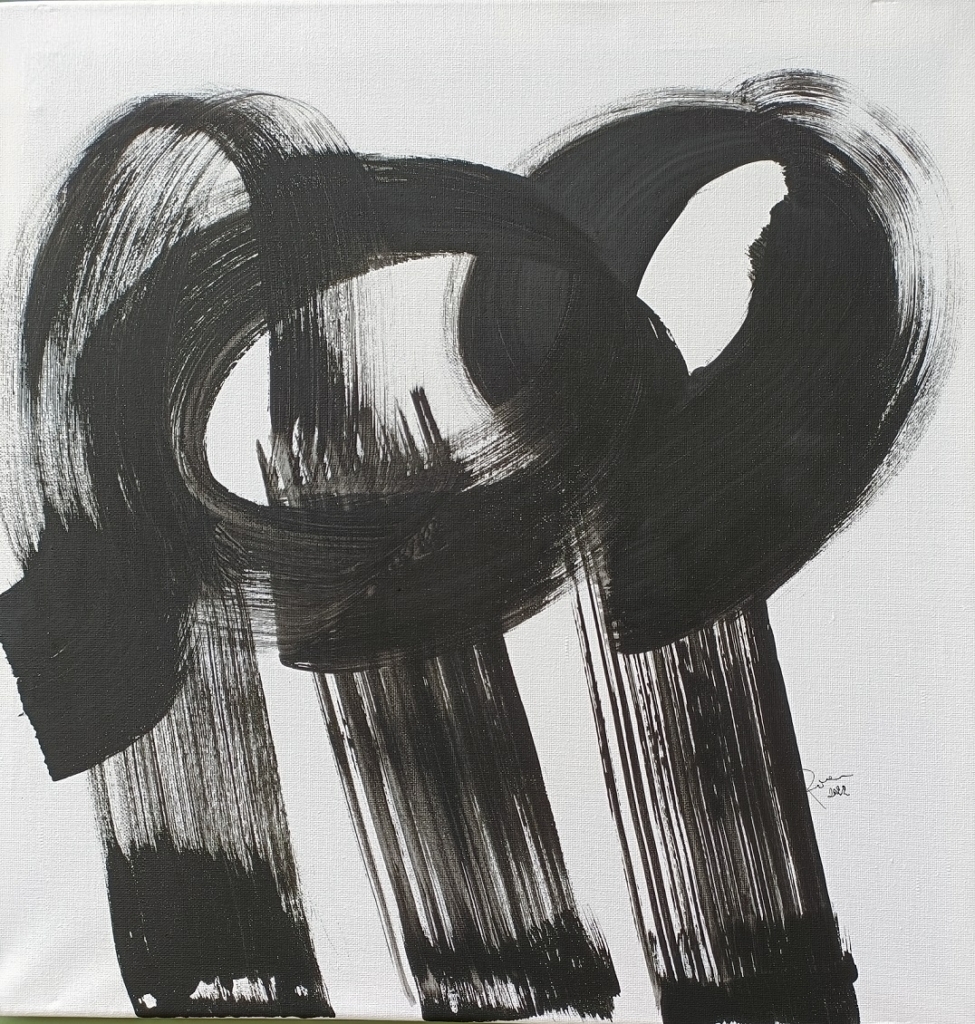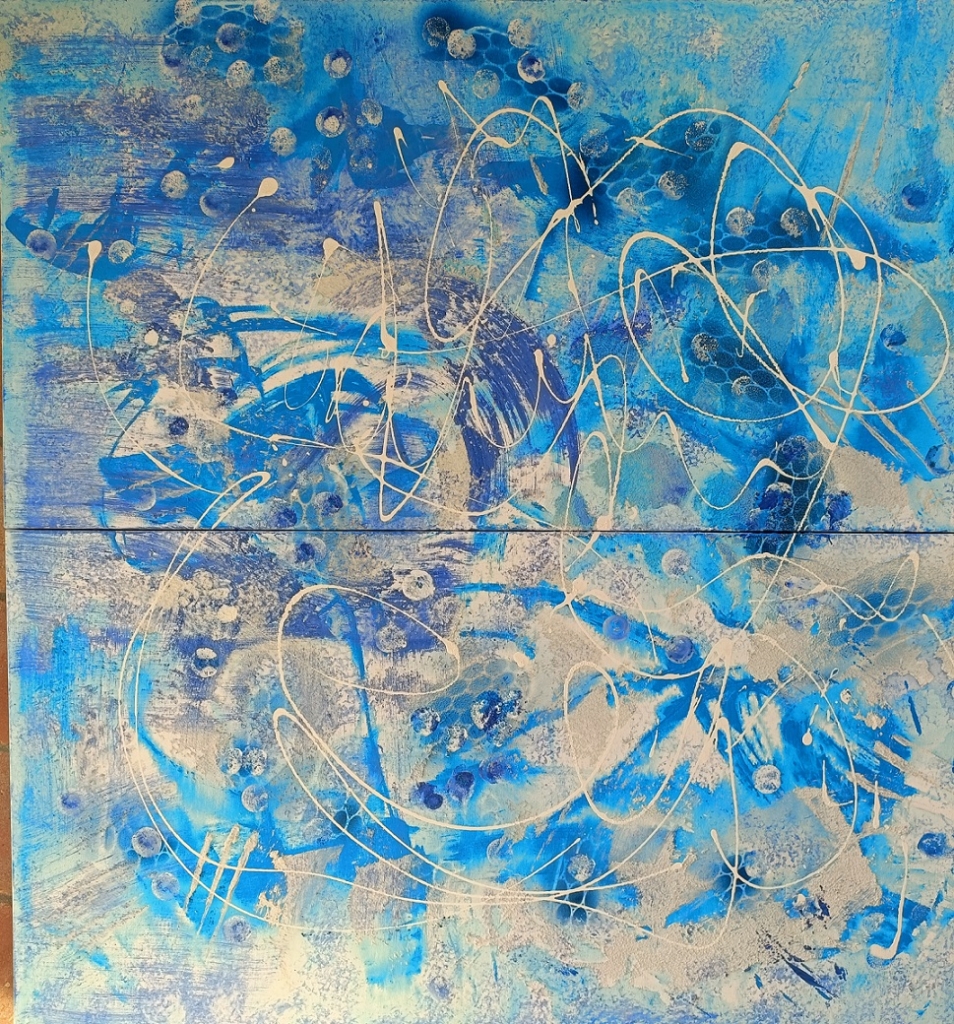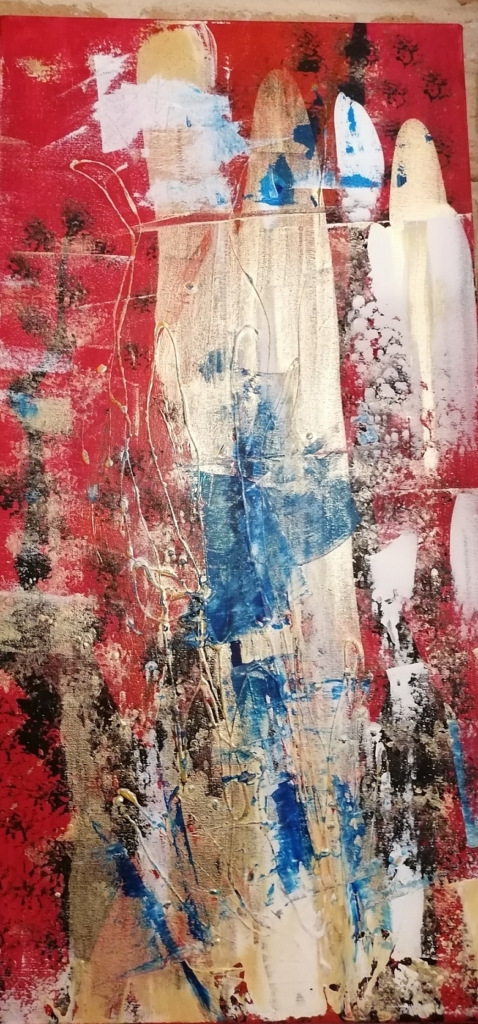di Marta Lock

La sua vita si è svolta per venti lunghi anni in paesi lontani e incredibilmente diversi dalla realtà italiana in cui è nata; la Nigeria, Dubai e Adu Dhabi sono luoghi incantati e pieni di spunti di arricchimento emozionale e personale che hanno lasciato un profondo segno nella sua sensibilità e anche nel suo percorso di maturazione e di assorbimento di tutte le sensazioni, gli odori e i colori in grado di avvolgere i suoi ricordi e di arricchire il suo linguaggio espressivo. Il suo approccio è aperto all’ascolto, pronto a ricevere e cogliere il minimo dettaglio attraverso cui le sue corde emotive vibrano predisponendosi così a dar vita a una manifestazione su tela di quel palpito; va da sé che per narrare una tale intensità di sensazioni, un’armonia di memorie vissute e di presente a cui ricondurre le esperienze del passato, sia impossibile per Piera Bachiocco attenersi alle regole della figurazione, perché significherebbe interrompere quella connessione con le energie che la circondano e con la necessità di lasciar fuoriuscire spontaneamente tutto ciò che in qualche modo è riconducibile a un profumo, un colore, un paesaggio osservato con gli occhi dell’anima. Consapevole della sua indole artistica intraprende gli studi più affini alla sua natura conseguendo il diploma presso l’Istituto d’Arte di Ancona, specializzandosi in Decorazione Pittorica e quello è stato il percorso che ha poi contraddistinto la sua intera esistenza perché ha avuto l’opportunità di insegnare disegno nella scuola media sia in Italia che all’estero, si è occupata di restauro e non ha mai smesso di voler apprendere, studiare, perfezionarsi con la medesima curiosità che contraddistingue gli artisti ma anche le persone che vivono per lungo tempo all’estero e che hanno costantemente la consapevolezza di doversi misurare con se stesse e con la realtà circostante per evolvere, seguendo corsi di conservazione e restauro dipinti, cimentandosi con il mosaico, con l’affresco, con la decorazione su vari materiali e con la doratura in foglia oro, quasi come se il suo istinto di misurarsi con diverse forme espressive fosse vitale per raccontare l’apertura all’ascolto e alle diverse interpretazioni dell’osservato. È per questo che il suo Espressionismo Astratto appare tanto sfaccettato, tanto molteplice nella sua apparenza. Piera Bachiocco non può non collegare ciascuna emozione a un particolare e unico approccio, a volte più segnico in cui l’idea in primo piano emerge e contrasta lo sfondo neutro, come nell’opera L’eleganza del nero; i tre moschettieri,

in cui le larghe linee scure si stagliano ed emergono in tutto il loro fascino, quella raffinatezza che spesso sfugge quando si aggiungono ulteriori tonalità. Forse in questa tela l’artista prende spunto dal continente in cui ha vissuto a lungo, l’Africa, in cui la primitiva e immediata espressione nel disegno è funzionale a lasciare un messaggio a chi osserva, un’immagine semplice eppure incredibilmente efficace per indurre l’osservatore a meditare su di essa. Poi in opere come il dittico Firmamento

si assiste non solo a un’amplificazione della gamma cromatica in cui le gradazioni di azzurro prendono il sopravvento e sembrano condurre l’osservatore in un mondo emozionale morbido e avvolgente, ma anche a un’interposizione comunicativa con le linee curve bianche che sembrano voler rompere l’equilibrio del turchese, come fossero elementi di disturbo funzionali a evidenziare quei piccoli dettagli, quei particolari che hanno reso indimenticabile il cielo a cui la memoria della Bachiocco fa riferimento. Non si ferma alla superficie della tela l’artista perché la sua fantasia non deve conoscere limiti nell’esprimersi, diversamente si genererebbe un condizionamento a sensazioni ed emozioni che scaturiscono nell’atto creativo e che non possono essere arginate da un solo supporto bensì hanno bisogno di trovare la concretezza in qualunque tipo di superficie, dal legno alla ceramica, dalla tela alla carta, purché quello specifico supporto sia funzionale e affine a ciò che sta emergendo dal suo mondo interiore. Approfondiamo ora la conoscenza di questa dinamica ed eclettica artista.
Piera, lei ha viaggiato per molti anni, vivendo in luoghi diversi tra loro ma affascinanti ciascuno per le proprie caratteristiche; quanto hanno contato quelle esperienze di vita nel suo percorso artistico di ricerca di uno stile che le calzasse? Quale tra i tre la ispira di più ancora oggi?
Il mio viaggio nell’arte è stato lungo e complesso perché avendo viaggiato molto non ho compreso subito il mio cambiamento nell’interpretare le idee artistiche che di volta in volta emergevano. Spesso iniziavo un’opera e poi la accantonavo e la riprendevo addirittura dopo anni cambiando completamente tutto. Dei paesi arabi ero affascinata dall’eleganza e dallo sfarzo visibili a ogni angolo ma dell’Africa mi hanno sempre attratta i colori, caldi e sgargianti così ho cercato con le mie pennellate di dare questo effetto flash con i colori.

Lei sembra non voler terminare il suo percorso di apprendimento e di sperimentazione, malgrado sia passata anche dall’altra parte della cattedra, cioè come insegnante di disegno. Crede sia importante per un artista continuare a evolvere e ad apprendere? Oppure invece il suo approccio è affine e tipico della sua natura di scopritrice di emozioni e della spontanea indole empatica e aperta verso tutto ciò che entra a far parte della sua vita o della sua sfera di attenzione?
Amo molto sperimentare, imparare, testare cose nuove, cerco di non essere mai ripetitiva perché sono la prima ad annoiarsi, non sopporto la routine, men che meno dal punto di vista artistico. Non appena vedo qualcosa, qualsiasi cosa, oggetti, colori, materiali che mi ispirano e mi danno emozioni avverto l’impulso di creare qualcosa. Anche se conosco già una tecnica pittorica, mi piace seguire dei corsi perché sono convinta che ci sia sempre qualcosa di nuovo da imparare; la mia indole mi spinge a mettermi costantemente in gioco.
Mosaico, affresco, decorazione, restauro ma alla fine sceglie sempre la pittura, come se tutte le altre discipline dovessero costituire un arricchimento e un completamento del suo amore primario, quello per la tela. Quanto influiscono le conoscenze acquisite durante lo studio di queste materie artistiche sulla sua espressività pittorica? C’è un messaggio interpretativo che il fruitore deve scoprire oppure le sue opere sono solo mezzi per condurlo a una riflessione su se stesso?
In ogni tela, anche se impercettibilmente, si possono intravedere o percepire tutte le mie esperienze artistiche, perché anche dal colore di un vetro o da una doratura fatta con il bolo, può evidenziarsi la tecnica che c’è dietro; certo è qualcosa che solo persone del settore o intenditori riescono a notare eppure sono sempre presenti. Per il resto il messaggio è quello emotivo, quello che il fruitore stesso deve capire di sé lasciandosi andare a ciò che le mie tele gli suscitano, senza cercare un mio significato bensì ponendosi in posizione di ascolto di quanto la propria interiorità gli suggerisce.

Quali sono stati i maestri del passato che l’hanno ispirata nel delineare il suo stile? E qual è la sua visione del fare arte?
I miei maestri del passato sono tanti anche perché ho cambiato spesso lo stile quindi direi che i miei quadri sono un concentrato di tante cose; ho notato nel corso della mia carriera che ogni volta che ho pensato di fare una cosa nuova ho scoperto che era già stata fatta, non si può più inventare niente, si può solo prendere spunto ed evolvere le linee guida per creare un linguaggio personale. Il mio mantra espressivo è la frase di Picasso: “Io non cerco trovo” mentre e la mia ispirazione è quella di Dostoevskij: “La bellezza salverà il mondo”.

Lei ha al suo attivo la partecipazione a molte mostre collettive in Italia e all’estero – Parigi, Budapest, Barcellona, New York, Montecarlo, Stoccolma, Zurigo, Cannes e Lussemburgo -, ha vinto diversi premi d’arte e le sue opere sono inserite nelle maggiori pubblicazioni dedicate all’arte contemporanea. Quali sono i suoi prossimi progetti?
Non ho grandissimi progetti, non sono più giovanissima, tutto ciò che desidero è continuare a creare e dare emozioni alle persone che guardano i miei quadri; ovviamente prenderò tutto ciò che arriva e che mi può appagare dal punto di vista creativo e che penso riesca a coinvolgere le persone che guarderanno le mie opere.
PIERA BACHIOCCO-CONTATTI
Email: pierabachiocco@gmail.com
Sito web: http://www.wix.com/pierabachiocco/art
Facebook: https://www.facebook.com/piera.bachioccofeliziani
Instagram: https://www.instagram.com/piera_bachiocco_feliziani/
Marta Lock’s interviews:
Piera Bachiocco, a life travelling to reach her expressive maturity
Her life has taken place for twenty long years in countries far away and incredibly different from the Italian reality in which she was born. Nigeria, Dubai and Adu Dhabi are enchanted places full of emotional and personal enrichment that have left a deep mark on her sensitivity and also on her path of maturation and absorption of all the sensations, smells and colours that can envelop her memories and enrich her expressive language. Her approach is open to listening, ready to receive and grasp the slightest detail through which her emotional chords vibrate, thus preparing herself to give life to a manifestation on canvas of that throbbing; it goes without saying that in order to narrate such an intensity of sensations, a harmony of lived memories and the present to which past experiences can be traced, it is impossible for Piera Bachiocco to abide by the rules of figuration, because it would mean interrupting that connection with the energies that surround her and with the need to spontaneously let out everything that in some way can be traced back to a perfume, a colour, a landscape observed with the eyes of the soul. Aware of her artistic nature, she embarked on the studies most akin to her nature, graduating from the Ancona Art Institute, specialising in Pictorial Decoration, and that was the path that then marked her entire existence because she had the opportunity to teach drawing in secondary schools both in Italy and abroad, she worked in restoration and never stopped wanting to learn, to study, perfect herself with the same curiosity that characterises artists, but also people who live abroad for a long time and who are constantly aware of the need to measure with themselves and the surrounding reality in order to evolve, following courses in painting conservation and restoration, trying her hand at mosaics, frescoes, decoration on various materials and gold leaf gilding, almost as if her instinct to experiment different forms of expression was vital to tell the story of her openness to listening and to different interpretations of the observed. This is why her Abstract Expressionism appears so multifaceted, so manifold in its appearance. Piera Bachiocco cannot help but link each emotion to a particular and unique approach, at times more sign-like in which the foreground idea emerges and contrasts the neutral background, as in the artwork L’eleganza del nero; I tre Moschettieri (The Elegance of Black; The Three Musketeers), in which the broad dark lines stand out and emerge in all their charm, that refinement that often escapes when further tones are added. Perhaps in this canvas the artist takes her cue from the continent where she has lived for a long time, Africa, where the primitive and immediate expression in the drawing is functional to leave a message for the observer, a simple yet incredibly effective image to induce the viewer to meditate on it. Then, in artworks such as the diptych Firmamento (Firmament), is visible not only an amplification of the chromatic range in which the gradations of blue take over and seem to lead the observer into a soft and enveloping emotional world, but also a communicative interposition with the curved white lines that seem to want to break the balance of the turquoise, as if they were disturbing elements functional to highlighting those small details, those particulars that made unforgettable that sky to which Bachiocco’s remembering is referred. The artist does not stop at the surface of the canvas because her imagination must know no limits in expressing itself, otherwise it would generate a conditioning to sensations and emotions that arise in the creative act and that cannot be contained by a single support but need to find concreteness in any type of surface, from wood to ceramics, from canvas to paper, as long as that specific support is functional and akin to what is emerging from her inner world. Let us now delve deeper into this dynamic and eclectic artist.
Piera, you have travelled for many years, living in different but fascinating places each with their own characteristics; how much have those life experiences counted in your artistic journey of searching for a style that fits you? Which of the three still inspires you the most today?
My journey in art has been long and complex because having travelled a lot I did not
immediately understood my change in interpreting the artistic ideas that emerged from time to time. I would often start an artwork and then put it aside and even pick it up again years later, changing everything completely. Of the Arab countries, I was fascinated by the elegance and opulence visible in every corner, but of Africa I was always attracted by the colours, warm and garish, so I tried to give this flash effect with my brush strokes.
You don’t seem to want to end your journey of learning and experimentation, despite the fact that you have also gone over to the other side of the desk, i.e. as a drawing teacher. Do you think it is important for an artist to keep evolving and learning? Or is your approach akin to and typical of your nature as a discoverer of emotions and spontaneous empathic and open nature towards everything that comes into your life or your sphere of attention?
I really love experimenting, learning, testing new things, I try never to be repetitive because I am the first to get bored, I can’t stand routine, least of all from an artistic point of view. As soon as I see something, anything, objects, colours, materials that inspire me and give me emotions, I feel the urge to create something. Even if I already know a painting technique, I like to take courses because I am convinced that there is always something new to learn; my nature drives me to constantly challenge myself.
Mosaic, fresco, decoration, restoration, but in the end you always choose painting, as if all the other disciplines should be an enrichment and completion of your primary love, that for the canvas. How much do the knowledge acquired during the study of these artistic subjects influence your pictorial expressiveness? Is there an interpretative message for the viewer to discover or are your artworks merely means to lead him to a reflection on himself?
In every canvas, even if imperceptibly, one can glimpse or perceive all my artistic experiences, because even from the colour of a glass or a gilding done with a bolo, one can see the technique behind it; of course it is something that only people in the industry or connoisseurs can notice, yet they are always there. For the rest, the message is an emotional one, what the viewer himself has to understand about himself by letting himself go to what my canvases arouse in him, without looking for a meaning of my own, but rather by placing himself in a position of listening to what his inner self suggests to him.
Which masters of the past have inspired you in shaping your style? And what is your vision of making art?
My past masters are many, also because I have often changed style, so I would say that my paintings are a concentrate of many things; I have noticed throughout my career that every time I thought of doing something new, I found out it had already been done, you cannot invent anything anymore, you can only take a cue and evolve the guidelines to create a personal language.
My expressive mantra is Picasso’s phrase: ‘I do not seek I find’ while my inspiration is Dostoevsky’s quote: ‘Beauty will save the world’.
You have participated in many group exhibitions in Italy and abroad – Paris, Budapest, Barcelona, New York, Monte Carlo, Stockholm, Zurich, Cannes and Luxembourg – to your credit, you have won several art prizes and your artworks are included in major publications dedicated to contemporary art. What are your next projects?
I don’t have any big plans, I am no longer very young, all I want is to continue to create and give emotions to the people who look at my paintings; of course I will take anything that comes along that can satisfy me from a creative point of view and that I think will succeed in involving the people who will look at my artworks.
